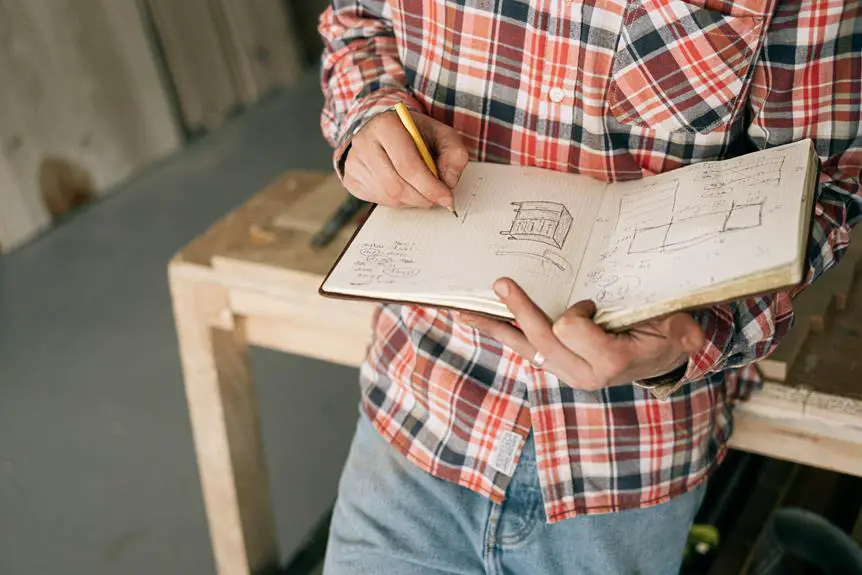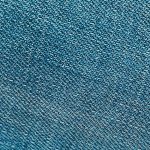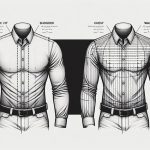So, you've decided to take on the noble quest of crafting your own pair of jeans. Well, look no further, because we've got the lowdown on the 5 essential fabrics for your DIY denim dreams.
From classic denim for that timeless look to stretch denim for a comfortable fit, and even raw denim for the purists out there, we've got you covered. Whether you're a seasoned pro or just starting out, mastering these fabrics will take your DIY jeans game to the next level.
Let's dive in and explore the world of denim, so you can create the perfect pair of jeans that are uniquely yours.
Key Takeaways
- Classic Denim is essential for achieving a timeless look and durability.
- Stretch Denim offers versatility with ease of movement and a comfortable fit.
- Selvedge Denim provides a classic, authentic look with a distinctive self-finished edge.
- Raw Denim allows for personalization through dyeing techniques and offers exceptional fading potential.
Classic Denim
If you're planning to make your own jeans, classic denim is the essential fabric to achieve that timeless look and durability. Classic denim, known for its sturdy weave and indigo dye, has been a staple in fashion for generations.
When working with classic denim for your DIY jeans, it's crucial to understand denim care. Pre-washing the fabric is essential to prevent shrinkage after your jeans are made. Always wash denim in cold water and avoid using harsh detergents to preserve the rich indigo color. Additionally, turning your jeans inside out before washing can help maintain the fabric's integrity.
To achieve that perfect fit and style, knowing how to work with classic denim is key. Understanding the grain of the fabric and the direction of stretch will ensure that your jeans aren't only stylish but also comfortable to wear. Seam finishes are also crucial in denim work to prevent fraying and ensure longevity.
Stretch Denim
Stretch denim is a versatile fabric that allows for ease of movement and a comfortable fit in DIY jeans. When considering denim alternatives, stretch denim stands out for its unique combination of durability and flexibility. This fabric is a game-changer for those seeking the classic denim look with added comfort and mobility.
The primary benefit of stretch denim is its ability to stretch and recover, offering a forgiving fit without sacrificing the authentic denim appearance. Whether you're bending, sitting, or walking, the stretch in the fabric moves with you, making it an ideal choice for everyday wear.
The advantages of using stretch denim in DIY jeans are numerous. First and foremost, the stretch in the fabric provides a more forgiving and comfortable fit, making it an excellent option for those who lead an active lifestyle. Additionally, the flexibility of stretch denim allows for greater ease of movement, making it a practical choice for a wide range of activities.
Moreover, the blend of cotton and elastane in stretch denim ensures that your DIY jeans maintain their shape even with frequent wear, offering both comfort and longevity.
Selvedge Denim
Selvedge denim is another essential fabric for DIY jeans, offering a classic, authentic look with its distinctive self-finished edge. You can appreciate the durability and timeless appeal of selvedge denim, making it a popular choice for creating your own high-quality jeans.
What sets selvedge denim apart is its unique construction technique. Unlike regular denim, which is made on modern projectile looms, selvedge denim is crafted on traditional shuttle looms. This method creates a tightly woven fabric with a clean, finished edge that resists unraveling. The result is a denser, more durable material that ages beautifully, developing unique fades and creases over time.
When working with selvedge denim for your DIY jeans, you'll notice the fabric's heft and sturdiness, making it both challenging and rewarding to sew. However, the effort pays off with jeans that aren't only stylish but also built to last.
With its rich history and superior quality, selvedge denim is a must-have for any denim enthusiast looking to craft their own premium jeans.
Raw Denim
Continuing from the previous point, another essential fabric for DIY jeans is raw denim. Raw denim offers a classic, unprocessed look and a durable, long-lasting quality. When working with raw denim for your DIY jeans project, keep in mind the following key points:
- Unprocessed Aesthetic: Raw denim is characterized by its unwashed, untreated appearance. This gives your jeans a unique, untouched vibe that develops distinct wear patterns over time.
- Durable and Long-Lasting: The sturdy, heavyweight nature of raw denim makes it an ideal choice for crafting durable, long-lasting jeans. They can withstand everyday wear and tear.
- Customization Potential: Due to its raw state, raw denim provides ample room for personalization through various dyeing techniques. This allows you to create a truly one-of-a-kind pair of jeans.
- Fade Potential: Raw denim is known for its exceptional fading potential. This makes it a favorite among denim enthusiasts who enjoy the process of naturally customizing their jeans through regular wear and tear.
When working with raw denim, exploring different dyeing techniques can offer a creative outlet for customizing the fabric to your desired color and style. This results in a truly unique and personalized pair of DIY jeans.
Lightweight Denim
When you're considering lightweight denim for your DIY jeans project, it provides a comfortable and breathable option for warmer weather. Lightweight denim, with its soft drape and airy feel, is perfect for creating jeans that are suitable for the spring and summer months. This fabric is a great choice for those who are looking for denim alternatives that offer both style and comfort. It's worth noting that lightweight denim is a key player in current DIY jean trends, as more and more people are opting for lighter weight fabrics to create their own custom jeans.
The versatility of lightweight denim allows for a wide range of design options. Whether you prefer a relaxed, loose fit or a more tailored silhouette, this fabric can accommodate various styles. Additionally, lightweight denim is often easier to sew and manipulate, making it an ideal choice for those new to DIY projects. Its softer texture also allows for a more comfortable wearing experience, making it a popular choice among DIY enthusiasts.
When it comes to DIY jean trends, lightweight denim is a must-have fabric for creating stylish and comfortable jeans that are perfect for the warmer seasons.
Frequently Asked Questions
What Are the Best Denim Fabrics for Distressing and Creating a Worn-In Look?
When creating a worn-in look with distressing techniques, opt for denim fabrics with a vintage wash. Look for a faded appearance that will give your jeans a worn-in, authentic feel. These fabrics are essential for achieving the perfect DIY vintage jeans.
Are There Any Eco-Friendly or Sustainable Denim Fabric Options for DIY Jeans?
For eco-friendly options and sustainable denim, consider organic cotton, hemp, or recycled denim for your DIY jeans. These fabrics are perfect for custom dyeing and distressing techniques while also being kinder to the environment.
Can Different Denim Fabrics Be Combined to Create Unique Custom Jeans Designs?
You can absolutely combine different denim fabrics to create unique custom jeans designs. Experiment with sustainable options, incorporate embellishment fabrics, and try out unique distressing techniques. Just remember to follow care instructions to maintain your creations.
What Are the Best Denim Fabrics for Creating Embellishments or Embroidery on DIY Jeans?
When creating embellishments or embroidery on DIY jeans, consider using sustainable denim options. Experiment with distressing methods and different denim fabrics to elevate your designs. Utilize embellishment techniques to add unique details and personalize your jeans.
Are There Specific Care Instructions for Different Denim Fabrics to Ensure the Longevity of DIY Jeans?
To ensure the longevity of your diy jeans, it's crucial to follow specific care instructions for different denim fabrics. Proper care can maintain the integrity of distressing techniques and preserve that sought-after worn-in look.
- Jaclyn Smith Fabric Coconut: a Review of This Rayon/Polyester Blend - June 29, 2025
- Jaclyn Smith Fabric Coconut: a Review of This Rayon/Polyester Blend - June 29, 2025
- How to Get Coconut Oil off Fabric Without Washing - June 29, 2025





